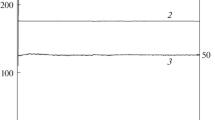Abstract
The heat transfer to a cylindrical water-cooled copper model was experimentally investigated in an induction VGU-4 high-frequency (HF) plasmatron of the Institute for Problems in Mechanics of the Russian Academy of Sciences. The model, 30 mm in diameter, equipped with a calorimetric transducer with a heat-adsorbing graphite surface, 13.8 mm in diameter, was exposed to the surface heating in the combined regime by nitrogen plasma and laser radiation and in the cases of the heating with only laser radiation or a nitrogen plasma jet. The experiments in the HF-plasmatron jets were performed at the pressure in the setup low-pressure chamber p = 1 × 104 Pa, nitrogen mass flow rate G = 2.4 g/s, and the plasmatron HF-generator anode power Na.p. = 22 kW. It is established that in the chosen experimental regimes the dissociated-nitrogen jet and the high-frequency induction discharge do not produce a considerable effect on the laser beam passing through them. The values of the heat flux density are obtained as functions of the laser radiation power delivered. The subsonic nitrogen plasma flow in the quartz discharge channel and in the low-pressure chamber of the VGU-4 setup is numerically modeled under the experimental conditions basing on the solution of the complete Navier–Stokes equations using the Patankar–Spalding method.







Similar content being viewed by others
REFERENCES
Park, C., Calculation of stagnation-point heating rates associated with stardust vehicle, J. Spacecr. Rockets, 2007, vol. 44, no. 1, pp. 24–32. https://doi.org/10.2514/1.15745
Dikalyuk, A., Kozlov, P., Romanenko, Y., Shatalov, O., and Surzhikov, S., Nonequilibrium spectral radiation behind the shock waves in Martian and Earth atmospheres, 44th AIAA Thermophysics Conf., Reston, Virginia, 2013, pp. 1–27. https://doi.org/10.2514/6.2013-2505
Surzhikov, S.T., Radiative-collisional models in non-equilibrium aerothermodynamics of entry probes, J. Heat Transfer, 2012, vol. 134, no. 3, pp. 1–11. https://doi.org/10.1115/1.4005127
Surzhikov, S.T. and Yatsukhno, D.S., Analysis of the flight data on convective and radiative heating of the surface of Martian Schiaparelli descent space vehicle, Fluid Dyn., 2022, vol. 57, no. 6, pp. 768–779.
Venkatapathy, E., Ellerby, D., Gage, P., Prabhu, D., Gasch, M., Kazemba, C., Kellerman, C., Langston, S., Libben, B., Mahzari, M., Milos, F., Murphy, A., Nishioka, O., Peterson, K., Poteet, C., Splinter, S., Stackpoole, M., Williams, J., and Young, Z., Entry system technology readiness for ice-giant probe missions, Space Sci. Rev., 2020. vol. 216, no. 2, pp. 1–21. https://doi.org/10.1007/s11214-020-0638-2
Laub, B. and Venkatapathy, E., Thermal protection system technology and facility needs for demanding future planetary missions, Planetary Probe Atmospheric Entry and Descent Trajectory Analysis and Science. ESA Publications Division, 2004, vol. 544, pp. 239–247.
Venkatapathy, E., Laub, B., Hartman, G.J., Arnold, J.O., Wright, M.J., and Allen Jr., G.A., Thermal protection system development, testing, and qualification for atmospheric probes and sample return missions: Examples for Saturn, Titan and Stardust-type sample return, Adv. Space Res., 2009, vol. 44, no. 1, pp. 138–150. https://doi.org/10.1016/j.asr.2008.12.023
Cushman, G., Alunni, A., Balboni, J., Zell, P., Hartman, J., and Empey, D., The laser enhanced arc-jet facility (LEAF-Lite): simulating convective and radiative heating with arc-jets and multiple 50-kW CW lasers, Joint Thermophysics and Heat Transfer Conf. 2018, p. 3273. https://doi.org/10.2514/6.2018-3273
Gokcen, T. and Alunni, A., CFD simulations of the IHF arc-jet flow: 9-inch nozzle, flow surveys, LEAF wedge calibration data, AIAA Aviation Forum, 2019, p. 3008. https://doi.org/10.2514/6.2019-3008
Alunni, A.I., Gokcen, T., and Boghozian, T., Laser-enhanced arc-jet facility wedge tests: Avcoat material performance under convective and radiative heating environments, Joint Thermophysics and Heat Transfer Conf., 2019, no. ARC-E-DAA-TN62912.
Chaplygin, A., Kotov, M., Yakimov, M., Lukomskii, I., Galkin, S., Kolesnikov, A., Shemyakin, A., and Solovyov, N., Combined surface heating by laser beam and subsonic nitrogen plasma jet, Fluids, 2023, vol. 8, no. 1, p. 11. https://doi.org/10.3390/fluids8010011
Kolesnikov, A.F. and Gordeev, A.N., High-frequency induction plasmatrons of the VGU series, in: Aktual’nye problemy mekhaniki: Fiziko-khimicheskaya mekhanika zhidkostey i gazov (Topical Problems of Mechanics: Physical and Chemical Mechanics of Liquids and Gases), Nauka: Moscow, 2010, pp. 151–177.
ASTM E422-05(2016). Standard Test Method for Measuring Heat Flux Using a Water-Cooled Calorimeter, ASTM International, West Conshohocken, PA, 2016.
Bottin, B., Chazot, O., Carbonaro, M., Van Der Haegen, V., and Paris, S., The VKI plasmatron characteristics and performance, Techn. Rep. Von Karman Institute For Fluid Dynamics, Rhode-Saint-Genese (Belgium), 2000.
Touloukian, Y.S. and DeWitt D.P., Thermophysical Properties of Matter, Purdue Univ., 1972, vol. 8.
Vasil’evskii, S.A. and Kolesnikov, A.F., Numerical investigation of flows and heat transfer in the induction plasma of a high-frequency plasmatron, in: Entsiklopediya nizkotemperaturnoy plazmy. Seriya B (Encyclopedia of Low-Temperature Plasmas, Serie B), 2008, vol. 1, part 2, pp. 220–234.
Patankar, S.V., Numerical Heat Transfer and Fluid Flow, CRC Press: Boca Raton, 2018.
Funding
This work was supported by the Russian Science Foundation (project No. 22-79-10083, https://www.rscf.ru/en/project/22-79-10083/). The experiments were carried out at the HF-plasmatron VGU-4 (IPMech RAS Research Resource Center, https://ckp-rf.ru/catalog/usu/441568/).
Author information
Authors and Affiliations
Corresponding author
Ethics declarations
The authors declare that they have no conflicts of interest.
Additional information
Translated by M. Lebedev
Rights and permissions
About this article
Cite this article
Vasil’evskii, S.A., Galkin, S.S., Kolesnikov, A.F. et al. Investigation of Heat Transfer Regimes in Subsonic Dissociated-Nitrogen Jets of a High-Frequency Induction Plasmatron under Additional Surface Heating by Laser Radiation. Fluid Dyn 58, 649–658 (2023). https://doi.org/10.1134/S0015462823600499
Received:
Revised:
Accepted:
Published:
Issue Date:
DOI: https://doi.org/10.1134/S0015462823600499



